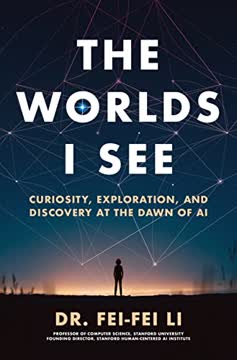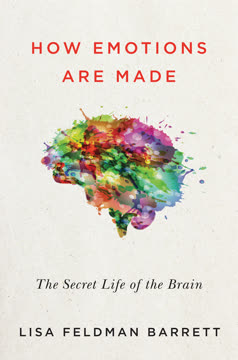Key Takeaways
1. The mind is flat: There are no hidden depths or unconscious thoughts
The mind is flat: that the very idea of mental depth is an illusion.
No hidden depths. The common belief that our minds contain vast reservoirs of unconscious thoughts, motivations, and memories is fundamentally mistaken. Our mental lives exist purely at the 'surface' level of conscious awareness. There are no pre-formed beliefs, desires, or memories hidden in the recesses of our minds.
Moment-by-moment creation. Instead, our thoughts, feelings, and memories are created on the spot, in response to current stimuli and situations. The brain is an improviser, generating interpretations and responses in real-time rather than accessing a store of pre-existing mental content. This challenges many traditional theories in psychology and neuroscience that posit complex unconscious processes.
Implications. This view has profound implications for how we understand ourselves and others. It suggests that introspection cannot reveal hidden truths about our psyche, and that techniques like psychoanalysis that claim to uncover buried mental content are misguided. Instead, we should focus on understanding how our minds creatively construct meaning in each moment.
2. Our conscious experience is a series of interpretations, not reflections of reality
We are only ever conscious of the results of our brain's attempts to make sense of the world – or rather, to make sense of some small part of it.
Constructed experience. Our subjective experience is not a direct reflection of reality, but an interpretation constructed by our brains. What we consciously perceive is the end result of complex neural processing, not raw sensory data.
Limited awareness. We are only aware of a tiny fraction of the information our senses receive at any given moment. Our brains selectively attend to and interpret certain aspects of our environment, constructing a coherent but highly simplified model of reality.
Illusion of completeness. Despite the limited and constructed nature of our conscious experience, we typically have the feeling of perceiving a rich, detailed, and complete world around us. This is what the author calls the "grand illusion" - our sense that we see and understand far more than we actually do at any given moment.
3. Perception is inference: We construct meaning from limited sensory input
Perception, then, is a process of incredibly rich and subtle inference – the brain is carefully piecing together the best story it can about how the world might be, to explain the agitations of its sense organs.
Active interpretation. Perception is not a passive reception of sensory information, but an active process of interpretation and inference. Our brains constantly generate hypotheses about what we're seeing, hearing, or feeling, based on limited sensory input and prior knowledge.
Filling in the gaps. Much of what we think we perceive is actually constructed by our brains to fill in gaps in sensory information. This is why we can recognize objects from partial views, understand speech in noisy environments, or see coherent images in abstract art.
Perceptual illusions. This inferential nature of perception explains why we're susceptible to various perceptual illusions. When our brains' assumptions about the world don't match reality, we can perceive things that aren't there or misinterpret what we see.
4. Emotions are interpretations of bodily states, not pre-existing inner feelings
Far from knowing our own minds, we are endlessly struggling to make sense of our own experiences – and we can often jump to the wrong conclusions.
Constructed emotions. Emotions are not pre-existing mental states that we simply become aware of. Instead, they are interpretations that our brains construct based on bodily sensations and situational context.
Physiological basis. The physical sensations we associate with emotions (e.g., increased heart rate, sweating) are often ambiguous. The same bodily state can be interpreted as different emotions depending on the context.
Cognitive labeling. Our conscious experience of emotion involves cognitively labeling and interpreting these bodily states. This process is influenced by cultural factors, personal history, and immediate context.
5. Decision-making is improvised in the moment, not based on stable preferences
We are, in short, relentless improvisers, powered by a mental engine which is perpetually creating meaning from sensory input, step by step.
No stable preferences. We don't have a set of stable, pre-existing preferences that we consult when making decisions. Instead, our choices are constructed in the moment based on the specific context and how we frame the decision.
Inconsistent choices. This explains why our decisions can be inconsistent or seem irrational. Different frames or contexts can lead to different choices, even when the underlying options are the same.
Implications for policy. This view challenges many assumptions in economics and policy-making about how people make decisions. It suggests that "nudges" and changes in how choices are presented can have significant effects on behavior.
6. The brain processes information sequentially, one interpretation at a time
We can think of this as specifying the values of some subset of the population of neurons. Each step in a sequence of thoughts then involves cooperative computation to find the most meaningful organization of everything else we know to find an answer that best fits that 'question'.
Sequential processing. Despite its massive parallel architecture, the brain can only focus on and interpret one set of information at a time. This is due to the cooperative nature of neural computation.
Attentional bottleneck. This sequential nature of processing creates an attentional bottleneck. We can't truly multitask or process multiple complex thoughts simultaneously.
Implications for consciousness. This view suggests that our stream of consciousness is a series of discrete interpretations, rather than a continuous flow. Each conscious thought is the output of a cycle of neural computation.
7. Our sense of self is a narrative construction, not a reflection of inner truth
Each of us is a unique tradition, guided and shaped by our past. Like traditions in music, art, literature, language or the law, we are capable of refinement, adjustment, reinterpretation and whole-sale reinvention.
Narrative self. Our sense of having a coherent, stable self is a story we construct to make sense of our experiences and actions. There is no underlying "true self" waiting to be discovered.
Constructed identity. Our personalities, beliefs, and values are not fixed traits, but flexible constructions that can change depending on context and how we interpret our experiences.
Implications for personal growth. This view suggests that significant personal change is possible through reinterpreting our experiences and consciously shaping the narratives we tell about ourselves.
8. Memory is creative reconstruction, not retrieval of stored information
Today's memories are yesterday's perceptual interpretations.
Reconstructive memory. Memories are not static recordings that we retrieve intact. Instead, they are actively reconstructed each time we recall them, incorporating new information and interpretations.
Malleability of memory. This reconstructive nature makes our memories highly malleable. They can be influenced by suggestion, current emotions, and new information we've acquired since the original event.
Implications for eyewitness testimony. This understanding of memory has important implications for fields like law, where eyewitness testimony is often treated as more reliable than it actually is.
9. Imagination and metaphor are central to human intelligence and understanding
The secret of intelligence is imaginative interpretation, rather than 'cold logic'.
Creative cognition. Human intelligence is fundamentally creative and imaginative, not just logical or computational. Our ability to see novel connections and apply knowledge flexibly is key to our cognitive abilities.
Metaphorical thinking. We understand and reason about the world largely through metaphors, mapping knowledge from one domain to another. This allows us to grasp abstract concepts and solve novel problems.
Implications for AI. This view suggests that creating truly human-like artificial intelligence may require replicating our capacity for imaginative and metaphorical thinking, not just improving computational power or logical reasoning.
10. The mind operates on precedents, not principles, constantly reinventing itself
We layer each momentary thought on top of past momentary thoughts, tracing an ever-richer web of connections across our mental surface.
Precedent-based cognition. Rather than operating on abstract principles or rules, our minds work by adapting and transforming precedents - past thoughts and experiences - to fit new situations.
Constant reinvention. This process of adapting precedents means we are constantly reinventing ourselves, thought by thought. Each new thought becomes a precedent for future thoughts.
Implications for personal growth. This view suggests that personal change happens gradually through laying down new precedents, rather than through sudden insights or willpower alone. It emphasizes the importance of consistently engaging in desired thought patterns and behaviors.
Last updated:
Review Summary
The Mind is Flat explores the controversial idea that our minds lack depth and operate through constant improvisation. Chater argues against the existence of an unconscious mind, positing that our thoughts and emotions are instantaneous creations based on past experiences. While some readers find the book insightful and well-researched, others criticize its repetitiveness and lack of consideration for alternative views. The book's central thesis challenges traditional psychological theories, sparking debate about the nature of consciousness, decision-making, and human intelligence.
Similar Books










Download PDF
Download EPUB
.epub digital book format is ideal for reading ebooks on phones, tablets, and e-readers.





